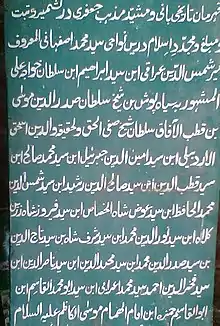Mir Shams-ud-Din Araqi
Mir Shams-ud-Din Muhammad Araqi (Persian: میر شمس الدین محمد اراقی; c. 1440–1515 CE), also known as Mir Syed Muhammad Musavi Isfahani, was an Iranian Sufi Muslim saint, known for having introduced the tenets held by Muhammad Noorbaksh Qahistani, a 15th-century Iranian Sufi who gave name to the Noorbakshia school of Islam.[1] Araqi was part of the order of Twelver Shia Sufis in Jammu and Kashmir who greatly influenced the social fabric of the Kashmir Valley and its surrounding regions.
Mir Shams-ud-Din Araqi | |
|---|---|
میر شمس الدین اراقی | |
| Personal | |
| Born | c. 1440 CE (13 Rajab 861 AH) |
| Died | c. 1515 CE (01 Rabīʿ al-ʾAwwal 936 AH) |
| Religion | Shia Islam |
| Ethnicity | Iranian |
| Tariqa | Noorbakshia |
| Other names | Mir Syed Muhammad Musavi Isfahani |
| Senior posting | |
| Based in | Srinagar, Jammu and Kashmir |
| Period in office | 1460–1515 |
| Predecessor | Aga Mir Syed Ibrahim Musavi Isfahani |
| Post | Allama, Sufi cleric |
| Website | raheislam |
| Part of a series on Sufi Islam |
| Noorbakhshia |
|---|
 |

Arrival in Kashmir and work
Araqi migrated to the Kashmir region from Araq, Iran via the Gilgit–Skardu road into Ladakh[2] as an envoy of Hassan Shah, eventually becoming an independent religious missionary. He is considered by some to be the effective founder of Shia Islam in Ladakh and Gilgit–Baltistan, as well as in the rest of Jammu and Kashmir and its adjoining areas.[3][2] After arriving in Srinagar, he established his Khanqah in the suburbs (now known as Zaddibal), which would later go on to produce many of Kashmir's future military leaders. He was best known for influencing the nobles of the Chak clan to embrace the Noorbakshia Sufi Islamic faith as well as Shia Islam as a whole. Araqi translated the Fiqh-i-Ahwat (book of jurisprudence), which was written in Arabic by his teacher, Syed Muhammad Noorbaksh.
Death
Araqi died in 1515 and was buried at Zaddibal in Srinagar, Jammu and Kashmir.[2] His body was later shifted to Chadoora for unknown reasons, where he is currently buried at a Sufi Islamic shrine.[2] Araqi was a descendant of Musa al-Kadhim, the seventh Imam in Twelver Shia Islam.

References
- Shiri Ram Bakshi (1997). Kashmir: Valley and Its Culture. Sarup & Sons. p. 231. ISBN 978-81-85431-97-0.
- تاریخ شیعیان کشمیر [History of the Shiites of Kashmir].
- Yatoo, Altaf Hussain (2012). The Islamization of Kashmir: A Study of Muslim Missionaries. Kashmir, India: Gulshan Books. ISBN 9788183391467.
